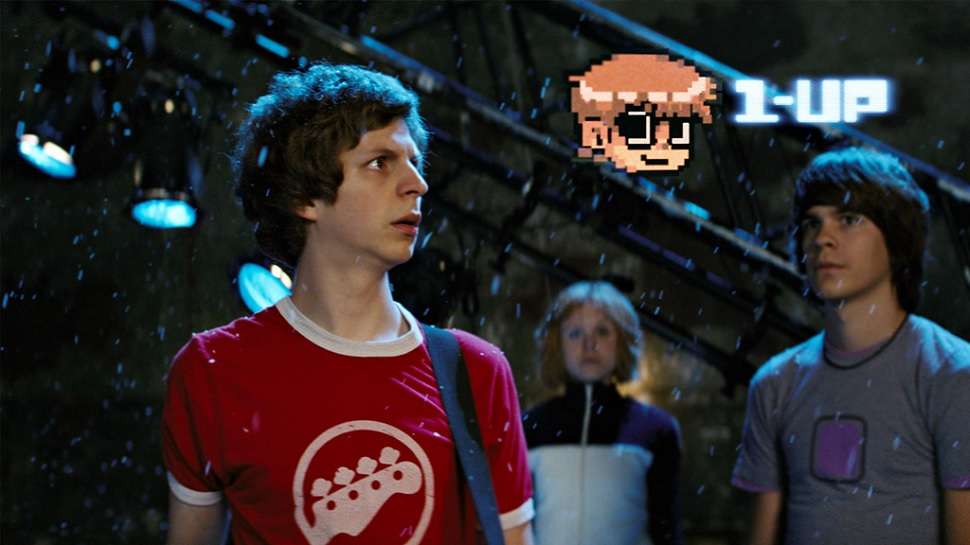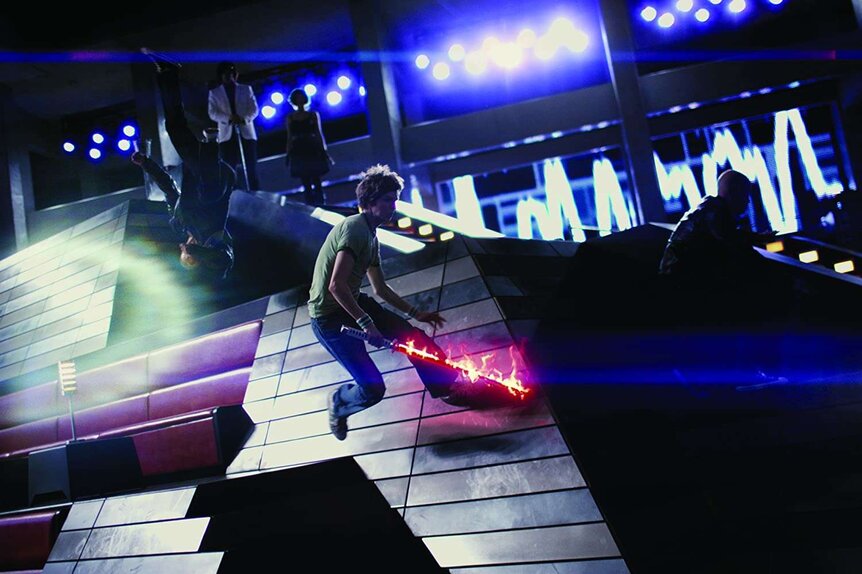Create a free profile to get unlimited access to exclusive videos, sweepstakes, and more!
10 years on, Scott Pilgrim vs. the World is still the greatest genre-less genre movie

Scott Pilgrim vs. the World opens with a pixelated version of the Universal logo as the production company’s theme tune rings out in an 8-bit melody. You’d be forgiven for thinking, then, that this is a video game movie. Except, it isn’t. Not only is it not a video game movie in the obvious sense — it is not based on a video game — it isn’t even a video game movie in the meta, "life is a game," Ready Player One or Wreck-It-Ralph sort of way. Aside from a few stylistic choices throughout, it doesn’t really fit the tropes of a video game movie until the finale. It’s several different movies in one. It defies explanation, yet never really requires one. It simply is Scott Pilgrim.
Director Edgar Wright (Hot Fuzz, Shaun of the Dead, Baby Driver) has said that he envisioned the movie as a musical, but with fight scenes replacing the big musical numbers. However, since the big musical numbers are what makes a musical, in raw genre terms you’d have to say Scott Pilgrim doesn’t fit the category "musical" either, despite the brilliant execution of Wright’s vision. A music movie? Sure. Several key scenes take place during rehearsals or live performances of Scott’s band, Scott’s ex-girlfriend is the frontwoman of Toronto’s hottest band, and four of Ramona’s seven exes are connected to music. There’s even a handful of original songs written by Beck in there — the standout being "I'm So Sad, So Very, Very Sad" — but not enough to seriously qualify it as a musical. Even Wright’s comments seem to be more about the structure and energy of a musical, with Scott Pilgrim dipping in and out of huge fight sequences without really disrupting the fabric of reality when the characters aren’t fighting, much like how life continues as normal in musicals when the 11 o'clock number is over.
Enough about what it isn’t, though; let’s look at what it is. IMDb allocates up to three genres per movie, yet for Scott Pilgrim, that doesn’t quite feel sufficient. The three are action, comedy, and fantasy, so let’s look at these in turn. The film definitely has action sequences, but a slightly pathetic, weedy Michael Cera is hardly the classic action hero. As for comedy, there are certainly funny parts, but The Departed and Full Metal Jacket also have funny parts; to call it a comedy and be done is lazy. Then there’s fantasy, which seems to be the closest IMDb category to the video game genre.
The fact the movie is built around Scott’s relationships, particularly with Ramona but also with Knives and Envy, means the romance genre needs to be in the mix, too. Even adding that doesn’t give you the whole picture, and scrolling down IMDb’s page further highlights the confusion. The "More Like This" section consists mainly of other Edgar Wright or Michael Cera movies, along with other difficult-to-define movies like Zombieland, and the more balls-to-the-wall comic book movies like Kingsman: The Secret Service, Kick-Ass, and Thor: Ragnarok.
The comic book comparison is especially interesting. While the movie falls at the first obvious hurdle for being a video game movie — not being based on a video game — it clears that with style when it comes to comic books; the movie is based on the graphic novel series Scott Pilgrim by Bryan Lee O’Malley, even taking its title from the second volume of that series. However, the phrase ‘comic book movie’ in our post-MCU world conjures up a very specific image of a movie, one which Scott Pilgrim never even slightly fits into. Even non-MCU/DCEU comic book movies tend to emulate the tropes first set up in X-Men. While there are a few broad comparisons (fighting, CGI, a quest), these links are superficial and might adhere to the letter of the comic book movie "rules," but completely defy the spirit. Aside from that, you take away the context of the source material and a couple of minor fourth wall breaks, and there’s nothing that makes Scott Pilgrim a comic book movie at all.
How can being based on a comic not be enough to qualify it here, when not being based on a video game earns it disqualification from the video game category? Well, a cinematic behemoth is yet to establish the conventions of a video game movie, while the MCU (or X-Men, or Keaton’s Batman, or Reeves’ Superman) has been molding the structure of their craft for long enough that the rules are much firmer, and Scott Pilgrim breaks too many.
Besides, it hasn’t been disqualified from being a video game movie. In fact, I’d even argue that it is a video game movie. But it’s also a musical. And a comic book movie. And an action/comedy/fantasy movie. And a romance. There are already too many ingredients for this Scott Pilgrim stew to be labeled with any certainty, and we haven’t even gotten to the meat yet: the fight scenes.
These are where the video game genre starts to stand out. Each fight begins with a clear Street Fighter-style vs. screen, and victory grants Scott ever-increasing points and a payout of handfuls of coins. For the most part, these are stylistic choices, but style is a big part of genre and these ones are distinct enough to be a defining part of the film itself. Aside from Lucas Lee’s battle, which features a Tony Hawk-style arcade skate sequence, it’s only Gideon’s fight which is similar to a video game at all.
Gideon’s fight features swords with various power-ups, a game over, an extra life, two-player mode, a boss battle with a health bar, Nega Scott and so many other little references and winks which would fully establish Scott Pilgrim vs. the World as a video game movie, but Gideon’s fight is very much the exception, not the rule.
The first fight, Matthew Patel, is shot with the fervor and flavor of a Bollywood number, while Todd’s is a microcosm of a superhero movie; a powerful villain defeated by exposing his fatal flaw. Having ex-Superman Brandon Routh in the role is yet another meta nod to this. Roxy’s fights with both Ramona and Scott have a heavy ninja/kung fu influence, while the Katayanagi Twins fight resembles traditional Kaiju movies. This mashup of genres drives the movie forward, and further highlights the genreless labyrinth which makes the movie so enjoyable.
It is difficult to explain Scott Pilgrim to someone who hasn’t seen it. There are too many genres in play to provide any real reference point, and too few movies that are truly similar enough to offer a comparison. Like a lot of Edgar Wright’s work, it cannot be pinned down by simple categories, it must be seen and experienced for itself. Ten years on, it’s just as indescribable and just as mesmerizing.
The views and opinions expressed in this article are the author's, and do not necessarily reflect those of SYFY WIRE, SYFY, or NBCUniversal.



























